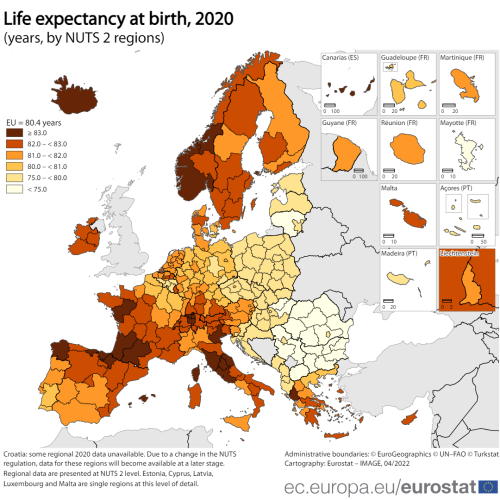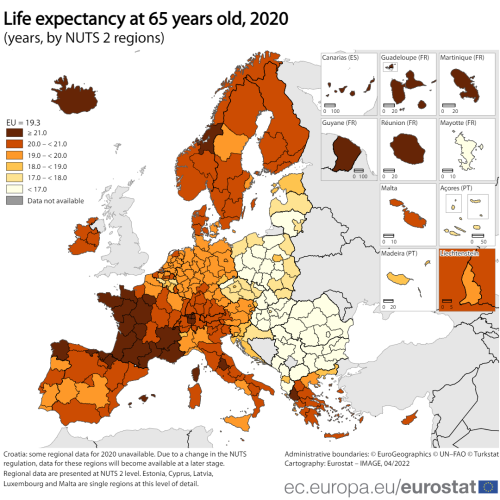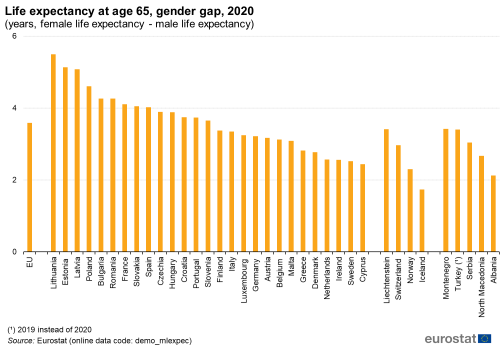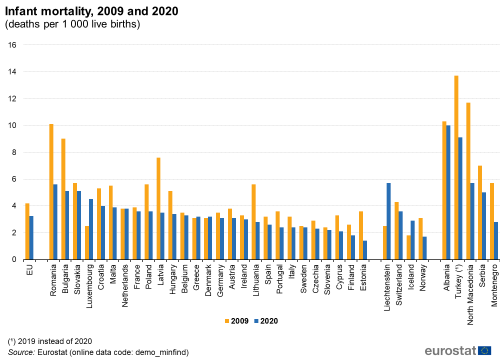Life Expectancy Has Continued to Rise in Europe Since 2014
Number of deaths
In 2020, 5 184 077 persons died in the EU, compared with 4 653 033 in 2019: a sharp increase of more than 530 000 deaths in one year (see Figure 1). The crude death rate, which is the number of deaths per 1 000 persons, was estimated at 11.6 in the EU in 2020 (1.2 more than 2019).

Figure 1: Number of deaths, EU, 1962-2020
(million)
Source: Eurostat (demo_gind)
Life expectancy at birth
The most commonly used indicator for analysing mortality is life expectancy at birth, i.e. the mean number of years that a person can expect to live at birth if subjected to current mortality conditions throughout the rest of their life. It is a simple but powerful way of illustrating the developments in mortality.
Life expectancy at birth in the EU was estimated at 80.4 years in 2020 (0.9 years lower than in 2019), reaching 83.2 years for women (0.8 lower than in 2019) and 77.5 years for men (1 year lower than in 2019).
Overall, between 2002 (the first year for which life expectancy data became available for all EU Member States) and 2020, life expectancy at birth in the EU increased by 2.8 years, from 77.6 to 80.4 years; the increase was 2.4 years for women and 3.2 years for men.

Figure 2: Life expectancy at birth, EU, 2002-2020
(years)
Source: Eurostat (demo_mlexpec)
Estimates calculated by Eurostat based on 2020 data suggest that in most Member States there was a significant decrease in life expectancy in 2020 (see Table 1 and Table 2). The largest decreases of total life expectancy at birth (males and females) were recorded in Spain (-1.6 compared with 2019) followed by Bulgaria and Poland (both -1.5), and then Lithuania and Romania (both -1.4).
Table 1 shows that in 2019 life expectancy increased in 25 EU Member States compared to the previous year, the exceptions being Greece and Cyprus. However, when comparing life expectancy in 2020 with 2019, it decreased by 1 year or more in 9 Member States (Belgium, Bulgaria, Czechia, Spain, Italy, Lithuania, Poland, Romania and Slovenia), it decreased by less than 1 year in 16 Member States, and increased by a modest 0.1 in Denmark and Cyprus.
As shown in Table 1, in 2020, life expectancy also decreased in all the EFTA countries, except in Norway.

Table 1: Life expectancy at birth, 1980-2020
(years)
Source: Eurostat (demo_mlexpec)
Across the EU regions, in 2020, the highest life expectancy at birth was in the French island of Corsica (84.0), followed by the Balearic Islands in Spain (83.9), the Epirus region in Greece (83.8), Galicia in Spain and Umbria in Italy (both 83.7) and Midi-Pyrénées in France (83.6). The EU regions with the lowest life expectancy at birth were in Bulgaria: North-West (72.1), North-Central (72.8) and North and South-East Bulgaria (72.9).

Map 1: Life expectancy at birth by NUTS 2 region, 2020
(years)
Source: Eurostat (demo_r_mlifexp)
Life expectancy at age 65
As can be seen in Table 2, life expectancy at age 65 also showed a sharp decrease in 2020. In 2020, life expectancy at 65 was estimated at 19.3 years (0.9 years lower than in the previous year), dropping to 21.0 years for women (0.8 years lower than 2019) and 17.4 years for men (0.9 years lower than 2019). In 2020, life expectancy at age 65 dropped significantly in most EU Member States, for both men and women (see Table 2).

Table 2: Life expectancy at age 65, 1980-2020
(years)
Source: Eurostat (demo_mlexpec)
Among EFTA countries, in 2020 Switzerland and Liechtenstein also recorded a drop in life expectancy at age 65, while Iceland and Norway registered a small increase. In 2020, life expectancy of men aged 65 ranged from 18.1 years in Liechtenstein to 20.3 years in Iceland, while the life expectancy for women aged 65 varied from a minimum of 21.5 years in Liechtenstein to a maximum of 22.2 years in Switzerland.
Looking at the regional level, in 2020 the regions in Southern France and North of Spain recorded the highest life expectancy at age 65.

Map 2: Life expectancy at age 65 by NUTS 2 region, 2019
(years)
Source: Eurostat (demo_r_mlifexp)
Gender gap in life expectancy
There are still major differences between countries when looking at the life expectancy of men and women. In 2020, life expectancy for women was still higher than life expectancy for men. With a gender gap of 5.6 years in 2020, newly born females in the EU could generally expect to outlive men. Furthermore, this gap varied substantially between EU Member States. In 2020, the largest difference between the sexes was found in Lithuania (10.0 years) and the smallest in the Netherlands (3.4 years) — see Figure 3.

Figure 3: Life expectancy at birth, gender gap, 2020 (years, female life expectancy - male life expectancy)
Source: Eurostat (demo_mlexpec)
Regarding the decrease in life expectancy for 2020, men were slightly more affected in the majority of the EU Member States, with the largest decrease in life expectancy recorded in Bulgaria (-1.6 years), Poland (-1.6 years), Lithuania, Spain and Romania (all -1.5 years).
In 2020, as in previous years EFTA countries recorded differences below the EU average between life expectancy at birth for men and women, ranging from 4.1 years in Switzerland to 2.9 in Iceland.
When looking at life expectancy at age 65, it can be seen that the gap between the sexes is smaller than the gap at birth. In 2020, women aged 65 in the EU could generally expect to outlive men by 3.6 years. The largest difference between the sexes in 2020 was found in Lithuania (5.5 years) and the smallest in Cyprus (2.4) and Sweden (2.5) — see Figure 4 .
Figure 4 shows that in 2020 women aged 65 in EFTA countries could expect to outlive men by a minimum of 1.7 years in Iceland to a maximum of 3.4 years in Liechtenstein.

Figure 4: Life expectancy at age 65, gender gap, 2020
(years, female life expectancy - male life expectancy)
Source: Eurostat (demo_mlexpec)
Infant mortality
Around 13 250 children died before reaching one year of age in the EU in 2020 (849 less than in the previous year); this was equivalent to an infant mortality rate of 3.3 deaths per 1 000 live births.

Figure 5: Infant mortality, 2009 and 2020
(deaths per 1 000 live births)
Source: Eurostat (demo_minfind)
One of the most significant changes which has led to an increase in life expectancy at birth has been the decrease in infant mortality rates. Between 2009 and 2020, the infant mortality rate in the EU fell from 4.2 deaths per 1 000 live births to 3.3 deaths per 1 000 live births. When extending the analysis to the last 20 years, the infant mortality rate has almost halved (6.2 deaths per 1 000 in 1999). The most significant reductions in infant mortality were generally recorded within those EU Member States which tended to record higher levels of infant mortality in earlier years when compared with the EU average.
In 2020, the highest infant mortality rates in the EU were registered in Romania (5.6 deaths per 1 000 live births) and Bulgaria and Slovakia (both 5.1 deaths per 1 000 live births), and the lowest were recorded in Estonia (1.4 deaths per 1 000 live births) and Finland (1.8 deaths per 1 000 live births).
In EFTA countries, infant mortality rates ranged from a minimum of 1.7 deaths per 1 000 live births in Norway to a maximum of 5.7 deaths per 1 000 live births in Liechtenstein.
Data sources
Eurostat provides information on a wide range of demographic data, including statistics on the number of deaths by sex, by age, by year of birth, as well as according to citizenship, country of birth and educational attainment; statistics are also collected for infant mortality and late foetal deaths. A series of mortality indicators are produced, which can be used to derive a range of information on subjects such as crude death rates or life expectancy measures by age, sex or educational attainment.
Context
In the last twenty years, the gradual increase in life expectancy in the EU has been one of the main factors contributing to the ageing of the EU population — alongside relatively low levels of fertility that have persisted for decades (see the articles on population structure and ageing and fertility statistics).
The outbreak of the COVID-19 pandemic, in 2020, will have a lasting impact on the way we live and work together. The outbreak came at a time when Europe had already been going through a period of profound demographic and societal change. More information of the work of the European Commission 2019-2024 to tackle the impact of demographic change in Europe can be found in the European Commission dedicated pages.
Source: https://ec.europa.eu/eurostat/statistics-explained/index.php/Mortality_and_life_expectancy_statistics